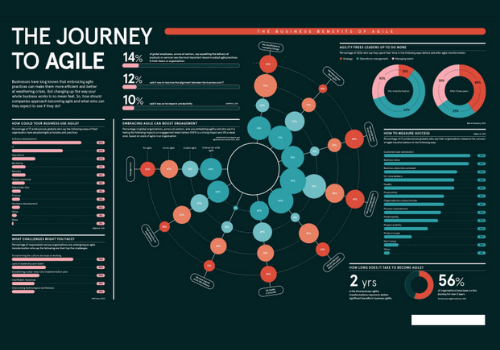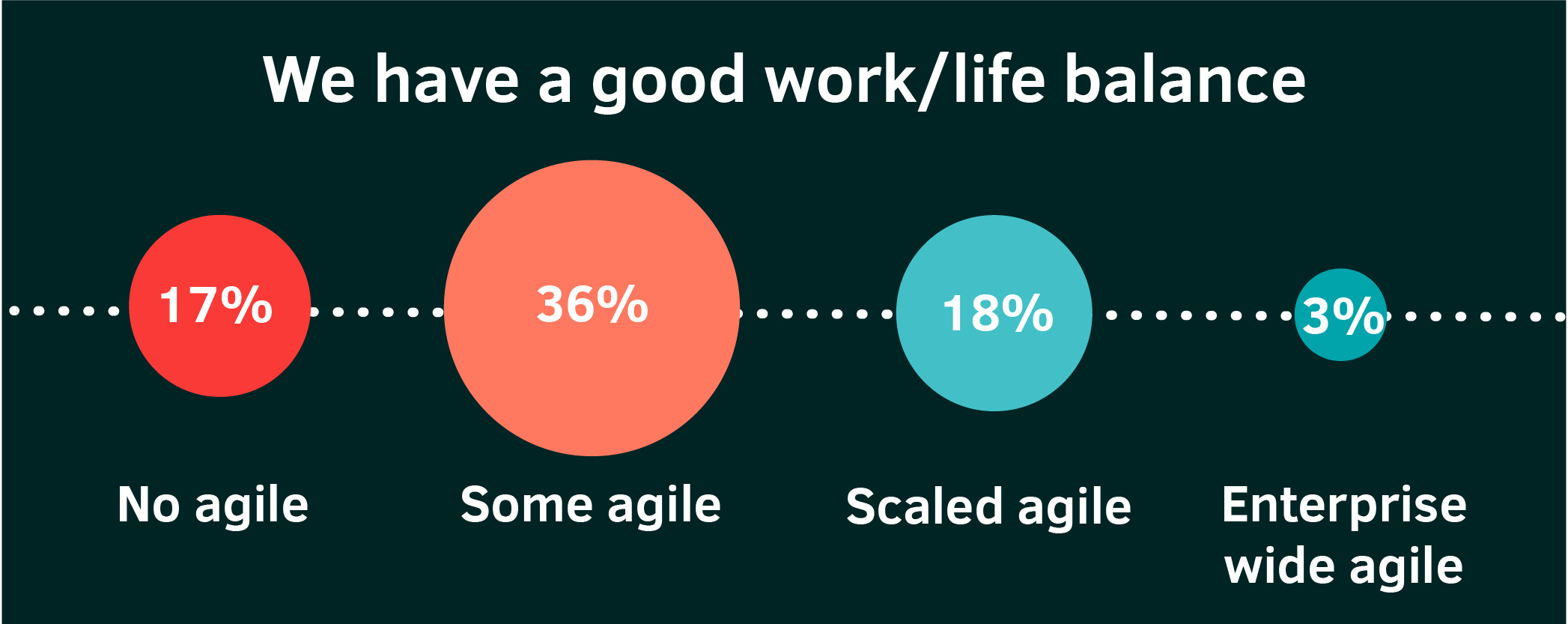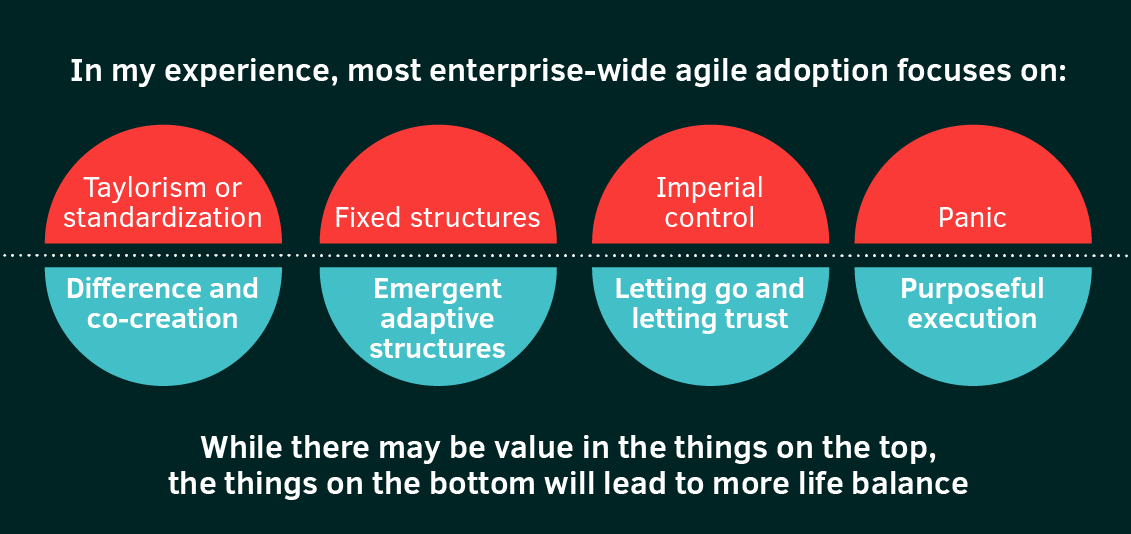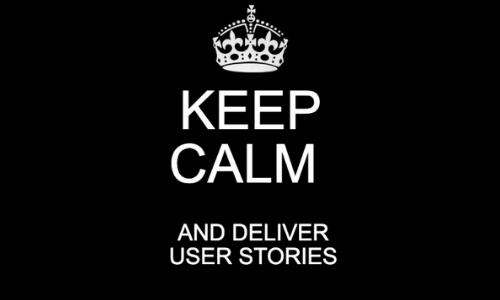Learn about purchasing for teams
Agile Burnout: Why Some Agile Orgs May Lack Work-Life Balance

The London Times’ Agile Business Report included a compelling infographic that illustrated a myriad of ways that business agility helps organizations and employees thrive. Including more inclusive leadership, the ability to put the team's best ideas forward and greater customer satisfaction. One startling statistic, however, indicates that only 3% of employees in organizations with system-wide agility report having “good work-life balance”.
Fundamentally, agility prioritizes people over processes. The Agile Manifesto promotes “sustainable development,” meaning that team members work at a “pace that can be maintained indefinitely”. We wanted to better understand, “where did it all go wrong?” Do companies severely misinterpret agile ways of working? What has led enterprise agile companies to create a workforce that may be on the verge of burnout?
We sat down with Kwasi Owusu-Asomaning, a Certified Enterprise Coach (CEC) and Certified Team Coach (CTC) for an agile coach’s perspective on what may have caused this disconnect. Here is what he had to say.

 Download the Report for a detailed View of the Infographic
Download the Report for a detailed View of the Infographic
Scrum Alliance: What was your first impression when you read that the most agile companies have the least amount of work-life balance?
Kwasi Owusu-Asomaning: When I first read this statistic, my heart started beating faster, I felt a tightening in my chest. I felt a sadness come over me. I had to take three deep breaths to even begin to address the question.
First, let me share my views on the notion of ‘Work/Life Balance’. It’s a parallel that often gets separated into two boxes: Work and Life. To me, this is absolutely nonsensical.
Life is the totality of who we are and what we stand for. It is our values, our purpose, our missions, our loves, our hates. Work is a portion of who we are—a portion of that totality. At times it may be a big part, but it is still a portion. Treating work and life as separate entities is a fallacy in my opinion.
How does this impact the statistic? This for me is exactly where the problem begins. Enterprises need to recognise that everything we are, is what shows up at work. This means enterprises need to truly get curious about what work-life balance means for their employees and actually listen to what they have to say.
SAI: Agile and scrum prioritize people over processes. What factors might be at play that causes companies that practice enterprise-wide agility to miss the mark here?
KOA: Referring back to the data, this is a very sad statistic for me. Sad, but a true reflection of what many enterprise-wide adoptions of agile still show. The chart below explains The chart below explains where I see the most common issues with enterprise-agile adoption in companies. I will go into more detail on each topic below:

Standardisation/Taylorism vs. Difference and Co-Creation
“What is the standard process that all these teams must follow to make our reporting easy?”, “Why is this team working totally different to that team?”, “This doesn’t fit the standard process.” As an agile coach, I hear these statements from business leaders time and again.
Standardising everything in enterprises is the lazy way to avoid doing the hard work to create the right environment for teams to flourish. Optimization solely to make processes more efficient at the organizational level only makes the work easier for a select few, and can incapacitate the people doing the work, the ones who deliver value directly to the customer.
This has a direct impact on those individuals 'lives’. When employees are not able to create a process that works well for their own work and their team, they tend to be stressed about changes and implementations that make their job harder. They go home and vent to someone, they don’t sleep well, and they come back to work stressed.
Conversely, there’s a lot of creativity in difference and co-creation. There’s joy in making something from one’s own cognitive ability. There’s freedom and liberation in co-creation. This enables teams to create solutions to suit who they are, how they are, and when they operate at their best. And they do this by subconsciously bringing the knowledge of their ‘life’ experiences in those moments as influences in what is co-created without even knowing it. This liberation brings a balanced self at work. When teams co-create they tend to be happier and perform better.
Related Article: Agile Leaders Hire Empowered Self-Organizing Teams
Fixed Structures vs. Emergent Adaptive Structures
Many enterprises are too fixed on the org chart to focus on the needs of teams and the customers they serve. Organisational structures are important, don’t get me wrong, but they need to serve teams, not the other way around. Here are two not-so-obvious ways organisations should shift their approach toward Emergent Adaptive Structures:
-
Build teams in the image of how adaptable and nimble you want your organisation to be in order to serve the ever-increasing demands of your customers.
-
In the agile world, we promote ‘building long-lasting cross-functional teams’ and there’s a very good reason for that - organisations love beautiful org charts. Organizations also love taking people to the work rather than taking work to people. So in an emergent, adaptive structure, you almost throw away the rule book or org structures/charts.
Executives should ask themselves the following questions:
-
How is my organisational structure serving my teams? Is it enabling them? Or is it disabling them with bottlenecks, 15-tiered decision making matrices etc.?
-
‘How am I building the best skilled teams in the industry? Can I throw them any ‘wicked’ problems to solve?
-
Am I inspiring teams to step forward and take these problems to solve or am I pushing onto them?
It is important to allow team structures to emerge and disband as needed to allow teams to solve ‘wicked problems’. Highly skilled teams are passionate, and they have the right skills. When a team is inspired to determine their own solutions to ‘wicked problems’ they’ll be motivated to bring their best, full-selves to work every day, they will need little help shifting gears into a high-performing state.
Imperial Control vs. Letting Go and Letting Trust
Much like standardisation/taylorism, imperial control creates a false sense of stability. Leaders think, “If I'm in control, then everything is fine or will go fine.” Conversely, when a leader trusts and lets go, there will be more individualized work across the entire organisation. Especially, in the VUCA (volatility, uncertainty, complexity, and ambiguity) world that agility was created to address.
Many organisations fear that if they let go and trust, teams will run wild and let loose. It’s a misconception and a deficiency of leaders not doing the tough inner work needed to run organisations. Imperial control is tangible, and tangibles are easy - controlling how people do the work, what processes they use - this only requires authority which is easily obtained by rank and influence. On the other hand, intangible solutions require vulnerability and physiological safety. We avoid these because they are hard. But letting go and trusting is where we make the most impact in all aspects of life; in work, in friendship, in marriage, in family etc.
The urge to control agile adoption at the enterprise level achieves the opposite effect of what agility is supposed to achieve. This is why, as the survey results indicate, many organisations have such terrible work-life balance.
Seek to understand what agility means to your organisation, use co-creation and difference to shape the change, leap into emergent adaptive structures (if this is too far fetched, start small with an experiment) then let go and trust - then watch the magic happen with your teams.
Related article: One-Team Culture: A First Step in Being Agile
Panic vs. Purposeful Execution
Panic Driven Development (PDD) - Google it, it’s actually a thing.

Organizations are often enamoured by the idea of agility, and quickly panic when their version of agility starts to run into resistance. Panic stems from not understanding that all systems are interconnected. For example, if teams are not aligned on the organisational vision and purpose, they may find themselves in a state of churn, fatigue, and disillusionment. This can hinder a team’s ability to materialize the agile promise of fast delivery of customer value.
As a response, rather than focusing on the highest level of value delivery; goals, visions, and objectives, organisations focus on the lowest level of value delivery. Then the panic of “you're not going fast enough” kicks in.
By focusing on the highest level of value delivery, teams are able to align with goals, visions, or objectives and execute in a purposeful and intentful way. This fullfills the very human need to have a purpose. This speaks to their mental well-being by creating a sense of community within the organization and thereby makes them happier at work.
In summary, work is part of life. Organisations need to create environments that allow teams to be their full selves at work and create structures, processes, and approaches that encourage them to work smarter and happier. The result will be there for everyone to see on the topic of work-life balance. It will also be evident in the outcomes delivered.
SAI: What steps can agile practitioners take to protect their own work-life balance?
KOA: Firstly, do some self-discovery.
-
Know yourself and do the internal work needed to understand what your triggers are, what gives you an off-centre feeling
-
Invest in the self-discovery that is necessary to bring your true, full self, in service of your clients/organisations.
-
Work to discover mechanisms or practices (meditation, journaling, supervision, etc) to bring yourself back to centre when you are off.
-
Define for yourself what “life balance” looks and feels like so that they will know when you don’t have it.
Secondly, put your coaching and systems thinking lens on when working with your organisation and leaders. As an agile practitioner, you become part of the orgnisational system simply by observing. The orgnisational system then impacts and influences how you show up. Systemic coaching capabilities can go a long way in helping you notice when the environment around you isn't as it should be and then you can take action.
Finally, agile practitioners need to get themselves, professional coaches. Practitioners and coaches need coaches too. Find yourself a mentor, buddy, or group of other coaches to help you see what you are missing.
Looking for more real-world agility tips? Subscribe to get scrum and agile resources in your inbox.
---
About Kwasi

Kwasi Owusu-Asomaning
Kwasi is a solution-focused coach with over 9 years of experience. He started his agile journey as a Scrum Master and has coached teams & individuals in organizations of different sizes and sectors. Kwasi focuses on systems coaching and systems thinking, focusing on a holistic picture rather than parts. Kwasi is a CTC who is Organization and Relationship Systems Coaching (ORSC) trained.
He is currently nearing completion of his Erickson Coaching International Solution-Focused coach diploma and also is enrolled in the inaugural InnerMBA program in partnership with SoundsTrue, LinkedIn, Wisdom 2.0, and Mindful NYU. Contact Kwasi about systems coaching training if you want to know more.










